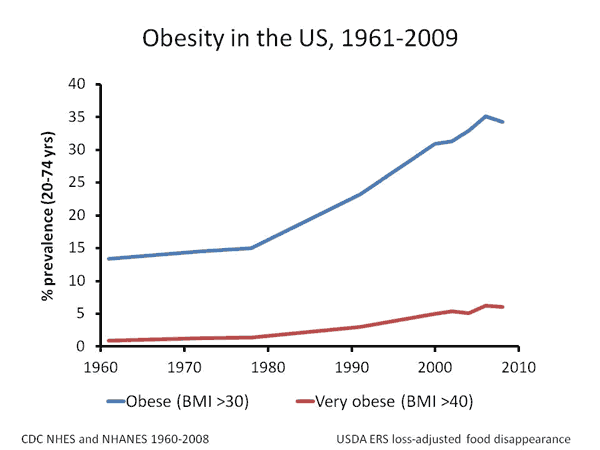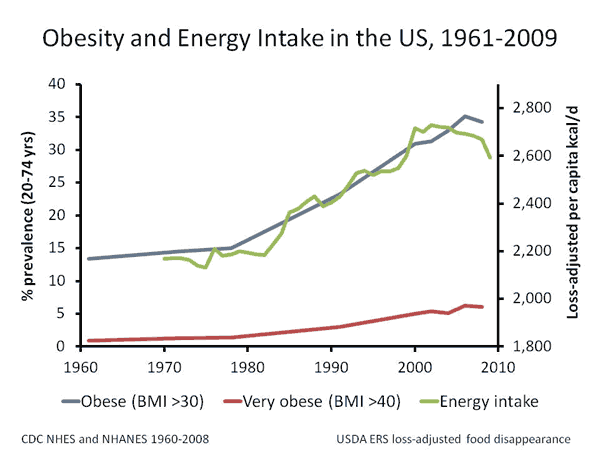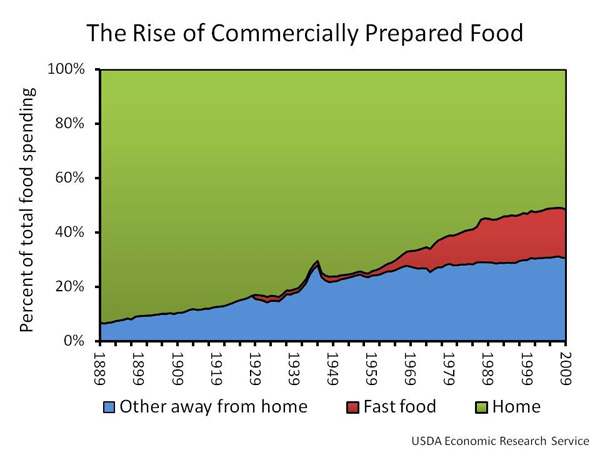[Boy, this is a really great summary of the current understanding of obesity and appetite. -egg]
Seduced by Food: Obesity and the Human Brain:
In 1960-1962, the US government collected height and weight measurements from thousands of US citizens. Using these numbers, they estimated that the prevalence of obesity among US adults at the time was 13 percent. Fast forward to the year 2007-2008, and in the same demographic group, the prevalence of obesity was 34 percent (
1). Most of this increase has occurred since 1980, when obesity rates have more than doubled among US adults, and extreme obesity has more than tripled. Welcome to the ‘obesity epidemic’. Today, more than one third of US adults are considered obese, an additional third are overweight, and largely as a consequence, each child born today has an estimated one in three risk of developing diabetes in his or her lifetime.

Since the obesity epidemic is a serious threat to public health and well-being, scientists have made it a research priority, and our understanding of its causes and consequences is rapidly expanding. Obesity can be the result of many interacting factors, including genetic makeup, developmental factors, physical inactivity, stress, insufficient sleep, social factors and smoking cessation. But dietary changes are clearly an outsized contributor. The obesity epidemic has closely paralleled a large (~20%) increase in per capita calorie intake, and according to the best available mathematical models, this increase can single-handedly account for the increase in body fatness over the last 30 years (
2,
3).

Calories are interesting, but let’s delve deeper. We didn’t just wake up one day and decide to eat more—something is driving our increased food intake. But what? Research accumulated over the last two centuries has revealed that the answer lies in the intricacies of the human brain.
The Human Brain and Obesity
In 1840, a German doctor named B. Mohr made a critical observation while performing autopsies on obese subjects: some of them had damage in a part of the brain called the hypothalamus (B. Mohr. Wschr Heilkd, 6:565–574. 1840). Over the ensuing century and a half, researchers gradually uncovered a network of circuits in the hypothalamus dedicated to maintaining the stability (homeostasis) of body fat stores, by regulating food intake, energy expenditure, and the deposition of energy in fat tissue. This research culminated in the discovery of an extraordinary hormone called leptin in 1994. Produced by fat tissue in proportion to its mass, leptin enters the circulation and acts in the hypothalamus to regulate body fat stores. If you consistently restrict food intake, fat mass declines and so does leptin, and this signals the hypothalamus to stimulate hunger and make the body use calories more efficiently, in an attempt to regain lost body fat (
4). Conversely, if you consistently overeat, the increase in fat mass and leptin suppresses appetite and increases calorie use until body fat stores have declined back to baseline (
5,
6). Leptin and a few other hormones are part of a negative feedback loop that acts unconsciously to keep fat mass in a specific range, sort of like a thermostat does for temperature (
7,
8). This is called the ‘energy homeostasis system’.
So if we have this built-in system to regulate body fatness, how does anyone become obese? Some researchers believe the energy homeostasis system defends against fat loss more effectively than fat gain. However, most obese people regulate their body fat just fine, but their brains ‘defend’ it at a higher level than a lean person. Going back to the thermostat analogy, in obese people it’s like the ‘temperature’ has been gradually turned up. That’s why it’s so hard to maintain weight loss—when body fat stores decline, the brain thinks it’s starving even if fat mass remains high—and it acts to regain the lost fat. If we want to understand how to prevent and treat obesity, first we have to understand why obese people defend a higher level of fat mass than lean people.
The most Fattening Diet in the World
To understand how this happens, let’s turn to animal research. Although rodents aren’t humans, they resemble us in many ways. Just like humans, rodents evolved to regulate body fat around an ‘optimal’ level to maximize survival and reproduction, and their systems for doing this are very similar to ours. Rodents also offer us the ability to control variables much more tightly than in human research. There are many ways to make a rat obese, but some are more effective than others. High-fat pelleted diets, composed of refined ingredients, are most common because they’re reliably fattening and their composition can be tightly controlled. But another diet, seldom used, is the most fattening of all: the ’cafeteria diet’. This diet has a lot to tell us about the expanding American waistline.
First described in 1976 by Anthony Sclafani, the cafeteria diet is basically a rat-sized buffet of human junk food, in addition to regular rat chow (
9). The menu for a recent cafeteria diet study included such delectable items as Froot Loops, mini hot dogs, peanut butter cookies, Cheez-its, Cocoa Puffs, nacho cheese Doritos, cake, and BBQ pork rinds (
10). These are what's known in the business as ‘palatable’, or pleasurable to the taste. On this regimen, rats ignored their regular chow, ate junk food to excess and gained fat at an extraordinary rate, far outpacing two comparison groups fed high-fat or high-sugar pelleted diets. Yes, human junk food happens to be the most effective way to overwhelm the body fat homeostasis system in rats, and neither fat nor sugar alone is able to fully explain why it’s so fattening. Importantly, over time, rats become highly motivated to obtain this diet—so motivated they’ll voluntarily endure extreme cold temperatures and electric shocks to obtain it, even when regular bland rodent pellets are freely available (
11,
12).
The cafeteria diet is an exaggerated version of an unhealthy human diet, and not many people eat quite that poorly. However, have a look at the top six calorie sources in the current US diet, in order of calorie contribution: grain-based desserts (cake, cookies, etc.), yeast breads, chicken-based dishes, sweetened beverages, pizza and alcoholic beverages (
13). Our eating habits aren’t as different from the cafeteria diet as we might like to believe.
In 1992, Eric Ravussin and collaborators tried to repeat the rodent experiment in humans. They gave volunteers unlimited access to a large variety of palatable energy-dense foods, in a setting where the researchers could monitor exactly what was eaten. Over the course of the next week, the volunteers more than doubled their usual calorie intake, gaining an average of five pounds (
14). Further studies showed a similar effect (
15,
16). Just as in rats, exposing humans to a large variety of palatable energy-dense foods causes an increase in food intake and rapid fat gain. To explain this, we need to bring our attention back to the brain.
My Neurons Made Me Fat
To understand why junk food causes fat gain in rats and humans, we have to explore two other circuits in the brain, beginning with the reward system. The reward system acts to gauge the desirability of food (among other stimuli) and reinforce and motivate behaviors that favor the acquisition of desirable food. For example, if you eat a strong cheese for the first time, maybe it won't taste very good to you. As it's digested, your reward system gets wind that it's full of calories, and the next few times you eat it, it tastes better and better until you like the flavor (
17,
18). This is called an acquired taste, and the reward system is what does the acquiring, motivating you to obtain a food it has deemed safe and desirable. This is the same process that allows children to learn to like vegetables—which are low-calorie, often bitter foods that are initially unpalatable-- if they’re repeatedly paired with fat, salt or some other desirable quality. The reward system does the same thing with foods/beverages that contain drugs, such as coffee and beer, gradually making bitter fluids palatable and then delicious.
Eventually, you may go out of your way to purchase the cheese or beer at the grocery store, and maybe you'll consume cheese or beer even if you aren't hungry or thirsty, simply because you like it. This is an example of the reward system reinforcing and motivating behaviors related to foods it considers desirable. What does the reward system consider desirable? Calorie density, fat, starch, sugar, salt, free glutamate (umami), certain textures (easily chewed, soft or crunchy, solid fat), certain flavors, an absence of bitterness, food variety, and drugs such as alcohol and caffeine. Our brains are highly attuned to these qualities because they’re all elements of nutritious, calorie-dense foods that would have sustained our ancestors in a natural environment, but today, the exaggerated combinations of these qualities used by processed food manufacturers, chefs and sometimes even home cooks overstimulate our natural reward pathways (
19). Commercial foods are professionally designed to maximize reward, because reward is precisely what keeps you coming back for more. Processed junk foods such as ice cream, fast food, sweetened soda, cookies, cake, candy, pizza and deep fried foods are all archetypal hyper-rewarding foods.
Palatability is a related concept—it’s determined in part by inborn preferences (e.g., a taste for sugar and energy dense foods), and in part by the reward system (acquired tastes). Palatability is governed by the hedonic system in the brain, which is closely integrated with the reward system. Imagine yourself sitting at the dinner table, stuffed after a large meal. Then the cake and ice cream appear, and suddenly you have enough room left for another 250 calories of food. Would you have eaten a large, unseasoned baked potato (250 calories) if someone had put one in front of you at that point? Foods that stimulate the hedonic system have a well known ability to increase food intake, and this effect can be replicated using drugs that activate these circuits directly (
20).
The reward system is what motivates you to get food and put it to your lips, every time you eat. When scientists shut it down in mice, they stop seeking food, even though they’ll still eat if it’s put into their mouths (
21). The hedonic system influences how much you eat once you begin a meal (
22). Together, reward and hedonic circuitry in the brain determine in large part how often you seek food, what foods you select, and how much you eat at a sitting.
Reward and hedonic systems, if stimulated in the right way by food or drugs, can increase food intake and body fatness. The marijuana ‘munchies’ (whose existence have been confirmed by science) are a good example of what happens when they’re chemically stimulated via the CB1 cannabinoid receptor in the brain (
23). One of the most effective weight loss drugs ever developed, Rimonabant, is basically ‘reverse marijuana’, blocking the very same CB1 receptor that marijuana activates. Although it clearly reduces food intake and body fatness, it has failed to gain FDA approval because of negative psychological side effects (big surprise).
The ability of reward and palatability to influence food intake and body weight is mediated by connections between reward/hedonic and energy homeostasis systems. For example, if you haven’t eaten in a while, your brain detects declining energy stores and acts to increase food intake. It does this by increasing your motivation to obtain food, and your enjoyment of food once you obtain it— known as ‘hunger’, this sensation is caused in large part by energy homeostasis systems activating reward and hedonic systems. But the connection goes both ways. Reward and hedonic systems also influence energy homeostasis systems, such that excessively rewarding/palatable food can increase food intake and the level of body fat that’s ‘defended’ by the brain (
24,
25,
26,
27). According to findings from my own research group (lab of Michael W. Schwartz) and others, the hypothalamus can also develop inflammation and chronic cellular damage that likely contributes to the defense of a higher fat mass as well, contributing to fat gain and making fat loss more difficult (
28,
29), but the reason for this is not yet clear.
Addiction is what happens when the reward system is over-stimulated by drugs, sex, food or other high-reward stimuli. In susceptible people (about 3 percent of the US population), highly palatable/rewarding foods are quite literally addictive, leading to binge eating behavior. For the rest of us, these foods may not literally be addictive, but they do often drive us to eat them more than we think we should, despite negative consequences to our weight and health.
Living in a Toxic Food Environment
How has the American diet changed over the years, as obesity rates have soared? Taking a broad perspective, the largest change is that our food has become more like the ‘cafeteria diet’, awash in a large variety of packaged foods, restaurant meals and sweetened beverages. This is illustrated by the following graph, showing the remarkable shift away from home-cooked food over the last 130 years. It shows the percentage of total food spending dedicated to food eaten at home, away from home, or as fast food between 1889 and 2009:

Diet trials have shown that a ‘simple’ diet, low in palatability and reward value, reduces hunger and causes fat loss in obese humans and animals, apparently by lowering the ‘defended’ level of fat mass (
30,
31,
32,
33). This may be a reason why virtually any diet in which food choices are restricted (e.g., Paleo, vegan, fruitarian), including diametrically opposed approaches like low-fat and low-carbohydrate diets, can reduce food intake and body fatness in clinical trials. As stated by Nora Volkow, director of the National Institute on Drug Abuse, “The common denominator of such diets is that neither allows consumption of the very caloric and seductive foods that combine high fat with high carbohydrates” (
34). Hyper-rewarding/palatable foods—candy, chocolate, ice cream, chips, cookies, cakes, fast food, sweetened beverages and pizza—are uniquely fattening and should be the first foods to go in any fat loss attempt. Some people will benefit from further simplifying the diet.
Dietary changes over the last several decades have contributed to the obesity epidemic. The solution to this problem is at once simple and challenging. Returning to a diet of simple home-cooked food, made from minimally refined ingredients, would probably stop the obesity epidemic in its tracks, although it would not be enough to return all currently obese people to a lean state. The challenge is finding the time and discipline to do this while commercial junk foods and sweetened beverages are tasty, cheap and constantly under our noses.
[Stephan's blog is Whole Health Source - Mark]


















